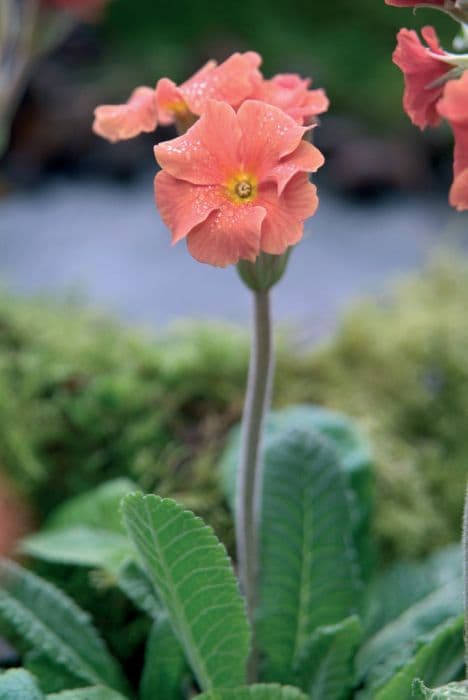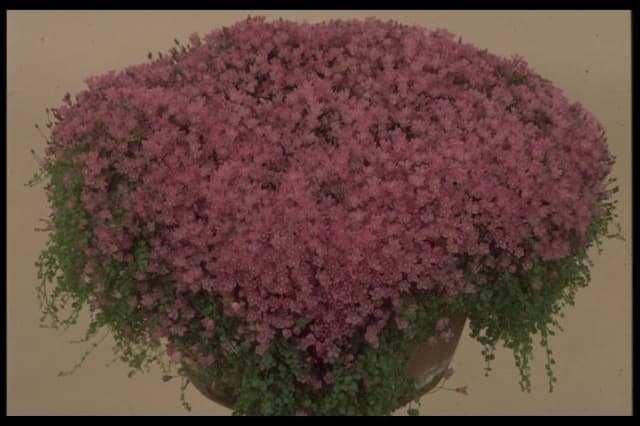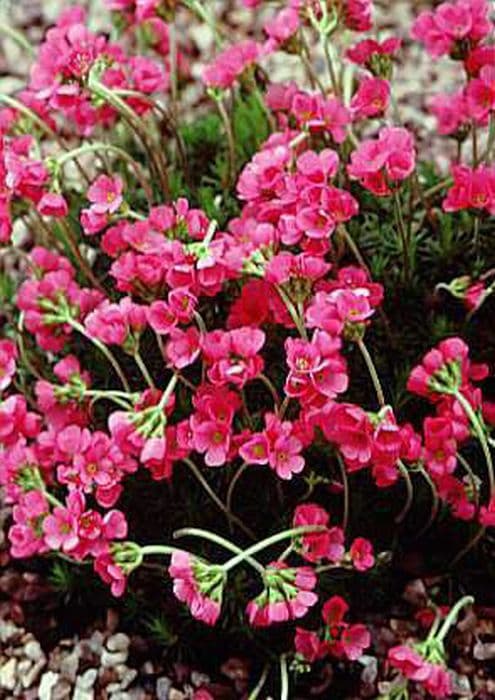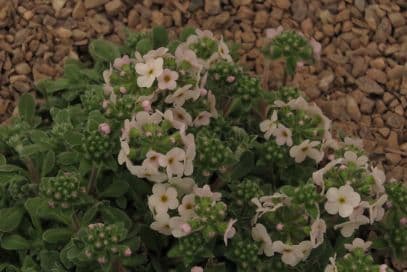Primrose Primula 'Don Keefe' (Pr/poly)

ABOUT
Primula 'Don Keefe' is a vibrant and ornate flowering plant commonly known as a primrose. This particular cultivar flaunts a lush rosette of green leaves that form an attractive, textured base for its stunning flowers. The leaves themselves are characterized by their crinkled or ruffled edges, which contribute to the plant's overall visual interest. Nestled among the foliage, the primrose blooms boast a remarkable display of color. They typically feature a layered arrangement of petals, creating a frilly, full appearance that contributes to the primrose’s charming allure. The flowers of Primula 'Don Keefe' usually present a striking contrast of hues, often showcasing a bright, sunny yellow center surrounded by petals that can range in color from deep reds and purples to softer pinks, blues, and whites. These vivid blossoms emerge on sturdy stalks, holding them aloft and creating a delightful showcase that is commonly seen in early spring through summer, adding a pop of color to gardens during these seasons.
About this plant
 Names
NamesFamily
Primulaceae
Synonyms
Don Keefe Primrose
Common names
Primula 'Don Keefe'
 Toxicity
ToxicityTo humans
Primula 'Don Keefe' is a cultivar of Primrose. Primroses are generally considered to have low toxicity to humans. However, they can cause mild irritation to the skin and digestive system if ingested. Touching the plant may result in contact dermatitis for sensitive individuals, and eating parts of the plant can potentially cause nausea, vomiting, or diarrhea. These symptoms are typically not severe, but it is advisable to seek medical attention if significant quantities of the plant are consumed or if symptoms persist.
To pets
Primula 'Don Keefe', commonly known as Primrose, can be toxic to pets if ingested. The main concern is the plant's saponins, which can cause mild to moderate digestive upset, such as vomiting or diarrhea, in dogs and cats. In most cases, symptoms are self-limiting, and severe poisoning is rare. However, if a pet ingests a large amount of the plant, or if symptoms are severe or persistent, it is important to consult a veterinarian.
 Characteristics
CharacteristicsLife cycle
Perennials
Foliage type
Evergreen
Color of leaves
Green
Flower color
Varies
Height
6 inches (15 cm)
Spread
12 inches (30 cm)
Plant type
Herb
Hardiness zones
5
Native area
Europe
Benefits
 General Benefits
General Benefits- Aesthetic Appeal: Adds vibrant color and visual interest to gardens with its striking blooms.
- Easy to Grow: Known for being low-maintenance and easy to care for, making it suitable for gardeners of all skill levels.
- Pollinator-Friendly: Attracts bees, butterflies, and other pollinators, supporting local ecosystems.
- Extended Blooming Season: Often has a long flowering period from late winter to early spring, providing color when few other plants are in bloom.
- Versatility: Can be used in a variety of garden settings, from borders and beds to containers and rock gardens.
- Cold Hardy: Tolerant of cold temperatures, which makes it suitable for cooler climates.
- Breeding Potential: Due to its hybrid nature, it has the potential for further breeding and development of new varieties.
 Medical Properties
Medical PropertiesThis plant is not used for medical purposes.
 Air-purifying Qualities
Air-purifying QualitiesThis plant is not specifically known for air purifying qualities.
 Other Uses
Other Uses- Photography: Primulas can be a subject for macro photography enthusiasts to capture the intricate details and patterns of their flowers.
- Artistic Inspiration: Artists may use the distinct colors and forms of Primulas as inspiration for paintings, illustrations, and textile designs.
- Education: Primulas can serve as practical examples in botany and horticulture classes to teach plant biology and hybridization.
- Cultural Symbolism: In some cultures, Primulas are associated with certain symbols or meanings and can be used in cultural ceremonies and traditions.
- Floral Arrangements: Primulas' vibrant blooms can be incorporated into mixed floral arrangements for aesthetic purposes.
- Special Events: Primulas can be grown and displayed during special events and flower shows as a sign of the beginning of spring.
- Garden Themes: These plants can be used to create themed gardens, such as fairy gardens or Victorian-inspired gardens.
- Eco-Friendly Confetti: Dried Primula petals can serve as an eco-friendly alternative to traditional paper confetti in celebrations.
- Color Dye: Historically, some Primula species could have been used to create natural dyes for coloring textiles or crafts.
- Insect Attraction: Primulas can attract beneficial insects to gardens, such as bees and butterflies, aiding in pollination.
Interesting Facts
 Feng Shui
Feng ShuiThe Primrose is not used in Feng Shui practice.
 Zodiac Sign Compitability
Zodiac Sign CompitabilityThe Primrose is not used in astrology practice.
 Plant Symbolism
Plant Symbolism- Hope and optimism: Primroses, in general, are often associated with the concept of hope and a positive outlook for the future, representing the return of happiness.
- Youthful beauty: The delicate and vibrant appearance of the Primula often symbolizes the beauty and innocence of youth.
- New beginnings: As one of the earliest flowers to bloom in spring, primroses are seen as heralds of a fresh start and the awakening of nature.
- Love and affection: Gifting primroses can be an expression of care, as they sometimes represent young love or the feeling of being unable to live without someone.
- Eternal existence: The long-lasting nature of many Primula species has linked them to concepts of existence and the everlasting cycles of life.
 Water
WaterPrimroses, including the 'Don Keefe' variety, prefer consistently moist soil without being waterlogged. Watering should be done thoroughly when the top inch of soil feels dry to the touch, which typically means once a week, but this can vary depending on climate conditions and indoor heating. It is best to use around 16 ounces (1 pint) of water for a standard 6-inch pot, adjusting for larger pots. During hot spells or when indoor heating is in use, check the moisture level more often as the soil may dry out more quickly. Always water at the base of the plant to avoid wetting the foliage, as this can encourage fungal diseases.
 Light
LightPrimrose 'Don Keefe' prefers bright, indirect light to thrive. A spot near a window that receives morning light or filtered sunlight throughout the day is ideal. Avoid placing them in direct afternoon sunlight, as this can be too intense and cause damage to the delicate leaves. East or north-facing windows are typically the best spots for these plants to receive the right amount of light without the harsh effects of the midday sun.
 Temperature
TemperaturePrimrose 'Don Keefe' enjoys cool to moderate temperatures, flourishing best between 50 and 70 degrees Fahrenheit. These plants can tolerate a brief dip down to 30 degrees Fahrenheit but should not be exposed to freezing temperatures for extended periods. They can also survive up to 80 degrees Fahrenheit, but higher temperatures may stress the plant and affect its blooming. The ideal range to keep your primrose happy is within that 50 to 70 degrees Fahrenheit sweet spot, mimicking its natural temperate habitat.
 Pruning
PruningPrimrose 'Don Keefe' benefits from pruning to remove faded or dead flowers and leaves, which encourages further blooming and prevents disease. This should be done as needed throughout the blooming season, which is typically late winter through spring. The best time to prune is when you notice spent blooms or yellowing leaves. Lightly pinching or snipping these off with clean scissors will help maintain the plant's compact, attractive shape and encourage new growth.
 Cleaning
CleaningAs needed
 Soil
SoilThe best soil mix for the Primrose 'Don Keefe' is a well-draining, humus-rich mix with a pH of around 6.0 to 7.0. You can achieve this by blending peat moss, loamy garden soil, and perlite or vermiculite in equal parts to ensure good aeration and moisture retention.
 Repotting
RepottingPrimrose 'Don Keefe' should be repotted every 1-2 years to refresh the soil and accommodate root growth. The best time to repot is in the late winter to early spring, just before the new growth starts.
 Humidity & Misting
Humidity & MistingPrimrose 'Don Keefe' thrives best in environments with high humidity, ideally around 50-60%. To maintain these levels, especially in drier indoor conditions, consider using a humidifier or placing the plant on a water-filled pebble tray.
 Suitable locations
Suitable locationsIndoor
Place in bright, indirect light; keep soil moist.
Outdoor
Partial shade, protect from harsh sun, keep soil moist.
Hardiness zone
4-8 USDA
 Life cycle
Life cycleThe life of the Primula 'Don Keefe', commonly known as a type of polyanthus primrose, begins with seed germination, which takes place in a moist, well-draining soil mix and under partial shade, often in late winter or early spring. After germination, the seedling stage follows, where the plant develops its first true leaves and a root system capable of taking up nutrients effectively. As the plant matures into the vegetative stage, it grows larger foliage and establishes a stronger root network to support flowering. The next stage is the flowering period, which typically occurs in early spring, when the primrose produces clusters of vividly colored flowers attracting pollinators and adding aesthetic value. Once pollinated, the flowers will develop into capsules containing numerous tiny seeds, marking the reproductive stage of the plant's life cycle. In the final stage, after seed dispersal, the parent plant may die back, especially if it is an annual, but if perennial, it may enter a period of dormancy, only to regrow from its rootstock the following season.
 Propogation
PropogationPropogation time
Spring-Early Summer
The most popular method for propagating Primula, commonly known as primrose, is by division. This is typically done in late summer after the blooming period has passed. To propagate by division, carefully lift the entire plant from the ground using a garden fork, ensuring you minimize root damage. Gently tease apart the clumps into smaller sections, each with a portion of roots and leaves attached. Replant these divisions promptly into moist, well-draining soil, spacing them about 6 to 12 inches (15 to 30 cm) apart to allow for ample growth. Water the new plants thoroughly to help establish them. This technique allows the Primula 'Don Keefe' to quickly settle in and grow on to produce blooms in the following season.









